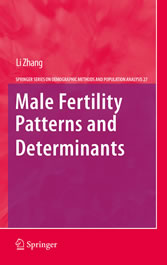Suchen und Finden
Preface
7
Acknowledgments
10
Contents
12
List of Figures
16
List of Tables
18
Part I Introduction
20
1 Introduction and Overview
21
1.1 Why Are Men Ignored in Fertility Studies
22
1.2 Male Fertility: An Important Component of Fertility Studies
24
1.3 A Growing Body of Literature on Male Fertility
25
1.4 Objectives and Structure of the Book
26
References
27
2 Review of Male Fertility Literature
29
2.1 Mens Participation in Fertility Decision-Making and Family Planning
29
2.2 Comparative Analyses of Male and Female Fertility Patterns and Determinants
31
2.3 Modeling Male Fertility and Constructing Two-Sex Models
33
2.4 An Evaluation of Prior Literature
34
2.5 Summary
38
References
39
3 Data and Methods
42
3.1 Data
42
3.1.1 The United Nations Demographic Yearbook
42
3.1.2 The Demographic and Health Surveys (DHS)
44
3.1.3 The World Fertility Surveys (WFS)
44
3.1.4 The National Survey of Family Growth (NSFG) Cycle 6
45
3.1.5 Other U.S. Surveys Containing Male Fertility Information
45
3.2 Taiwan-Fukien Demographic Fact Book
45
3.3 The Quality of Male Fertility Data
46
3.4 Statistical Methods
49
3.4.1 Descriptive Analysis and Ordinary Least Square (OLS) Regression
50
3.4.2 The Poisson Regression Models
50
3.4.3 Sample Weights and Survey Commands Using Stata
51
3.5 Summary
52
References
53
Part II Male and Female Fertility Differentials in Rates
55
4 A Cross-Sectional Analysis of Male and Female Fertility in 43 Countries and Places, 1990-1998
56
4.1 Research Background
57
4.2 Data
58
4.3 Measures
58
4.4 Results
59
4.4.1 Male and Female TFRs
59
4.4.2 Male and Female ASFRs
63
4.5 Conclusion and Discussion
67
References
71
5 Male and Female Fertility in Taiwan: Trends and Transitions, 1975-2004
72
5.1 Study Objectives
72
5.2 Data, Measures and Methods
73
5.3 Results
73
5.3.1 Male and Female Fertility Trends and Transitions, 1975--2004
74
5.3.2 Male and Female ASFRs in Taiwan, 1949--2002
77
5.3.3 Male and Female Fertility Differentials by Educational Attainment, 1974--2002
79
5.3.4 Male Fertility in Counties and Cities of Taiwan, 2002
85
5.4 Discussion and Summary
92
References
93
Part III Male and Female Fertility Differentials in Determinants
95
6 Demographic, Socioeconomic Characteristics, and Male and Female Fertiltiy
96
6.1 Linking Demographic Characteristics to Fertility
96
6.2 Previous Literature on Socioeconomic Characteristics and Fertility
99
6.3 Data, Measures and Methods
102
6.4 Results
107
6.4.1 Descriptive Statistics
107
6.4.2 Demographic Characteristics and Fertility Differentials by Gender
111
6.5 Socioeconomic Characteristics and Fertility Differentials by Gender
117
6.6 Conclusion and Discussion
123
References
127
7 Religion, Religiosity and Male and Female Fertility
130
7.1 Theories on Religion and Fertility
131
7.2 Research Hypotheses
132
7.3 Data, Methods and Variables
135
7.4 Results
136
7.4.1 Descriptive Results
137
7.4.2 Statistical Methods and Results
143
7.5 Conclusion and Discussion
147
References
152
8 The Influence of Cohabitation on Male and Female Fertility
155
8.1 Linking Cohabitation and Female Childbearing
155
8.2 Racial and Ethnic Differences in the Relationship of Cohabitation and Fertility
156
8.3 Socioeconomic Status, Family-Background Characteristics, and Nonmarital Fertility
157
8.4 The Proximate Determinants, Cohabitation and Fertility
158
8.5 Data, Variables and Methods
159
8.6 Results
161
8.6.1 Descriptive Results
161
8.6.2 Poisson Regression Results
169
8.7 Conclusion and Discussion
182
References
186
9 Cultural Inheritance and Male and Female Fertility
189
9.1 Theories and Hypotheses
190
9.2 Data, Variables and Methods
191
9.3 Results
197
9.3.1 Descriptive Results
197
9.3.2 The Poisson Regression Results
199
9.4 Conclusion and Discussion
200
References
203
10 Conclusion
205
10.1 Summary of Findings
206
10.1.1 Male and Female Fertility Differentials in Rates
206
10.1.2 Male and Female Fertility Differentials in Determinants
207
10.2 Implications
209
10.3 Underreporting Births by Younger Men
210
10.4 Future Prospects
211
References
212
Index
214
Alle Preise verstehen sich inklusive der gesetzlichen MwSt.








